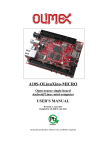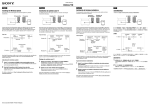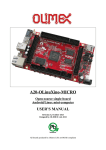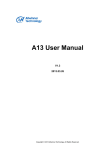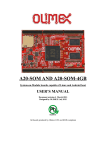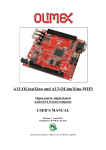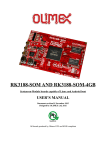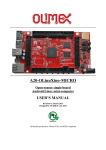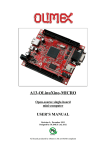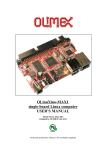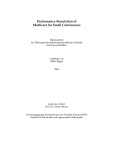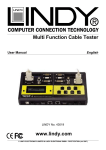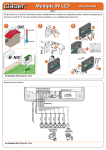Download A10S-OLinuXino-MICRO-4GB
Transcript
A10S-OLinuXino-MICRO Open-source single-board Android/Linux mini-computer USER’S MANUAL Revision C, September 2013 Designed by OLIMEX Ltd, 2013 All boards produced by Olimex LTD are ROHS compliant OLIMEX© 2013 A10S-OLinuXino-MICRO user's manual DISCLAIMER © 2013 Olimex Ltd. Olimex®, logo and combinations thereof, are registered trademarks of Olimex Ltd. Other product names may be trademarks of others and the rights belong to their respective owners. The information in this document is provided in connection with Olimex products. No license, express or implied or otherwise, to any intellectual property right is granted by this document or in connection with the sale of Olimex products. This work is licensed under the Creative Commons Attribution-ShareAlike 3.0 Unported License. To view a copy of this license, visit http://www.creativecommons.org/licenses/by-sa/3.0/. This hardware design by Olimex LTD is licensed under a Creative Commons Attribution-ShareAlike 3.0 Unported License. The software is released under GPL. It is possible that the pictures in this manual differ from the latest revision of the board. The product described in this document is subject to continuous development and improvements. All particulars of the product and its use contained in this document are given by OLIMEX in good faith. However all warranties implied or expressed including but not limited to implied warranties of merchantability or fitness for purpose are excluded. This document is intended only to assist the reader in the use of the product. OLIMEX Ltd. shall not be liable for any loss or damage arising from the use of any information in this document or any error or omission in such information or any incorrect use of the product. This evaluation board/kit is intended for use for engineering development, demonstration, or evaluation purposes only and is not considered by OLIMEX to be a finished end-product fit for general consumer use. Persons handling the product must have electronics training and observe good engineering practice standards. As such, the goods being provided are not intended to be complete in terms of required design-, marketing-, and/or manufacturing-related protective considerations, including product safety and environmental measures typically found in end products that incorporate such semiconductor components or circuit boards. Olimex currently deals with a variety of customers for products, and therefore our arrangement with the user is not exclusive. Olimex assumes no liability for applications assistance, customer product design, software performance, or infringement of patents or services described herein. THERE IS NO WARRANTY FOR THE DESIGN MATERIALS AND THE COMPONENTS USED TO CREATE A10S-OLinuXino-MICRO . THEY ARE CONSIDERED SUITABLE ONLY FOR A10S-OLinuXino-MICRO. Page 2 of 36 OLIMEX© 2013 A10S-OLinuXino-MICRO user's manual Table of Contents DISCLAIMER............................................................................................................. 2 CHAPTER 1: OVERVIEW........................................................................................5 1. Introduction to the chapter.......................................................................................................5 1.1 Features.....................................................................................................................................5 1.2 Target market and purpose of the board...............................................................................6 1.3 Board variants..........................................................................................................................6 1.4 Organization.............................................................................................................................6 CHAPTER 2: SETTING UP THE OLINUXINO BOARD.....................................7 2. Introduction to the chapter.......................................................................................................7 2.1 Electrostatic warning...............................................................................................................7 2.2 Requirements........................................................................................................................... 7 2.3 Powering the board..................................................................................................................8 2.4 Button functions and NAND image restore in Android....................................................... 9 2.5 Prebuilt software......................................................................................................................9 CHAPTER 3: A10S-OLinuXino-MICRO BOARD DESCRIPTION...................11 3. Introduction to the chapter..................................................................................................... 11 3.1 Layout (top view)................................................................................................................... 11 3.2 Layout (bottom view).............................................................................................................12 CHAPTER 4: THE ALLWINNER A10s MICROCONTROLLER.....................13 4. Introduction to the chapter.....................................................................................................13 4.1 The microcontroller...............................................................................................................13 4.2 Block diagram........................................................................................................................ 14 CHAPTER 5: CONTROL CIRCUITY................................................................... 15 5. Introduction to the chapter.....................................................................................................15 5.1 Reset........................................................................................................................................15 5.2 Clocks......................................................................................................................................15 5.3 Power supply circuit.............................................................................................................. 15 CHAPTER 6: CONNECTORS AND PINOUT......................................................16 6. Introduction to the chapter.....................................................................................................16 6.1 Communication with the A10s..............................................................................................16 6.1.1 USB-OTG communication (NAND firmware repair/update)..................................................................16 6.1.2 UART0, UART1, UEXT interface..............................................................................................................17 6.1.3 JTAG DEBUG.............................................................................................................................................. 18 6.2 SD card connectors................................................................................................................18 6.2.1 SD/MMC1 slot..............................................................................................................................................18 6.2.2 SD/MMC2 slot..............................................................................................................................................19 6.3 PWR jack................................................................................................................................20 6.4 LINE_IN socket connector....................................................................................................20 6.5 AUDIO_OUT socket connector............................................................................................ 21 6.6 USB_OTG...............................................................................................................................21 Page 3 of 36 OLIMEX© 2013 A10S-OLinuXino-MICRO user's manual 6.7 USB_HOST.............................................................................................................................22 6.9 Ethernet.................................................................................................................................. 23 6.10 HDMI connector.................................................................................................................. 25 6.11 MIC/TV.................................................................................................................................26 6.12 GPIO-1 (General Purpose Input/Output) 14pin connector ............................................26 6.13 GPIO-2 (General Purpose Input/Output) 40pin connector ............................................26 6.14 GPIO-3 (General Purpose Input/Output) 10pin connector.............................................28 6.15 LCD_CON 40pin connector ...............................................................................................28 6.16 Jumper description..............................................................................................................30 6.17 Additional hardware components...................................................................................... 31 CHAPTER 7: SCHEMATICS..................................................................................32 7. Introduction to the chapter.....................................................................................................32 7.1 Eagle schematic......................................................................................................................32 7.2 Physical dimensions...............................................................................................................33 CHAPTER 8: REVISION HISTORY AND SUPPORT........................................ 34 8. Introduction to the chapter.....................................................................................................34 8.1 Document revision................................................................................................................. 34 8.2 Board revision........................................................................................................................ 34 8.3 Useful web links and purchase codes...................................................................................35 8.4 Product support..................................................................................................................... 36 Page 4 of 36 OLIMEX© 2013 A10S-OLinuXino-MICRO user's manual CHAPTER 1: OVERVIEW 1. Introduction to the chapter Thank you for choosing this OLinuXino single board computer from Olimex! This document provides a user’s guide for the A10S Olimex OLinuXino board. As an overview, this chapter gives the scope of this document and lists the board’s features. The document’s organization is then detailed. The A10S-OLinuXino-MICRO development board enables code development of applications running on the A10s microcontroller, manufactured by Allwinner Technology from China. OLinuXino is an open-source, open-hardware project and all documentation is available to the customer. 1.1 Features The board has the following set of features (note about the difference between the two versions of the board): • A10S Cortex-A8 processor at 1GHz, 3D Mali400 GPU, NEON • 512MB DDR3 RAM • 4GB NAND Flash (only in the A10S-OLinuXino-MICRO-4GB version; comes with built-in Android image – no SD card required) • USB High-speed host with power control and current limiter • USB-OTG with power control and current limiter • HDMI output with ESD protectors • 100MBit native Ethernet • Audio Line-input • Audio Headphones output • UEXT connector • LCD connector to work with 4.3, 7.0, 10.1" LCD modules from Olimex • 50 GPIOs on three GPIO connectors • MicroSD card connector • SD/MMC card connector • DEBUG-UART connector for console debug with USB-SERIAL-CABLE-F • STATUS LED • Power LED • 2KB EEPROM for MAC address and other storage • 5 BUTTONS with ANDROID functionality + BOOT/REC and POWER buttons • Microphone input on connector (not populated) • Composite TV-output on connector (not populated) • JTAG-DEBUG connector (not populated) • UART1 connector (not populated) • +5V input power supply, noise immune design • 4 mounting holes Page 5 of 36 OLIMEX© 2013 A10S-OLinuXino-MICRO user's manual 1.2 Target market and purpose of the board The boards from the OLinuXino family are easy to setup and powerful. It is possible to use them in almost any application as a host board. They are suitable for embedded programming enthusiasts, Linux and Android gadget fans (they can just use the board as a media center or fully functional Linux-PC for instance) and also professionals (since its low cost makes it very good solution for application-orientated embedded systems). The main usage of the board is software embedded development without the urge of understanding perfectly the hardware. The strong points of the boards are the processor speed, the small form factor and the low price-toproductivity ratio. Customers have full access to the technical documentation of the board. The software is released under General Purpose License and the board is considered open-hardware – all schematics and board design files are available to the customer under the Creative Commons AttributionShareAlike 3.0 Unported License. 1.3 Board variants There are two major board variants. According to the names: A10S-OLinuXino-MICRO-4GB and A10S-OLinuXino-MICRO. The 4GB version has a built-in NAND memory suitable for the storage of an operating system without the need of a SD card. The 4GB version comes with already programmed Android 4.2.2 image. The other Olimex boards with close characteristics are the ones with A13 and A10/A20 microcontrollers. The A13 boards feature a generation older processor but since they have been longer on the market they have better Linux support. The A10 boards feature the bigger (than A10s) processor of the Allwinner A10 family. The A20 boards feature the new dual core processor and pack exceptional (for an embedded device) computing speed. Additional Linux support and features are added overtime. The Linux support is a work in progress and you should not expect full Linux support after the initial volume of such boards have become available on the market. If you are in a hurry consider the older OLinuXino designs (which have almost everything supported, have examples available and so on). 1.4 Organization Each section in this document covers a separate topic, organized as follow: – Chapter 1 is an overview of the board usage and features – Chapter 2 provides a guide for quickly setting up the board and software notes – Chapter 3 contains the general board diagram and layout – Chapter 4 describes the component that is the heart of the board: the A10s – Allwinner processor – Chapter 5 is an explanation of the control circuitry associated with the microcontroller – Chapter 6 covers the connector pinout, peripherals and jumper description – Chapter 7 provides the schematics and the dimensions of the board – Chapter 8 contains the revision history, useful links and support information Page 6 of 36 OLIMEX© 2013 A10S-OLinuXino-MICRO user's manual CHAPTER 2: SETTING UP THE OLINUXINO BOARD 2. Introduction to the chapter This section helps you set up the OLinuXino development board for the first time. Please consider first the electrostatic warning to avoid damaging the board, then discover the hardware and software required to operate the board. The procedure to power up the board is given, and a description of the default board behavior is detailed. 2.1 Electrostatic warning OLinuXino is shipped in a protective anti-static package. The board must not be exposed to high electrostatic potentials. A grounding strap or similar protective device should be worn when handling the board. Avoid touching the component pins or any other metallic element. 2.2 Requirements In order to set up the A10S-OLinuXino-MICRO optimally one or more additional items may be used. They might be generally placed in three categories: Required - items that are needed in order to achieve minimum functionality; Recommended – items that is good to have in order to be able to interact with the most important of the features of the board; Additional – items that provide additional access or expand the features of the board. Required items: - USB type A to USB mini cable – to connect to a personal computer; used for powering the board and uploading new Android image to the NAND memory (if your board has 4GB NAND) - Input device – either a mouse/keyboard or touchscreen LCD - Output device – either HDMI cable + HDMI-enabled monitor/screen/projector; or OLIMEX LCD (TS) display + 40-pin CABLE-IDC40-15cm; or USB-SERIAL-CABLE-F + personal computer (for Linux and/or Android debugging) - mini SD card with compatible image – if you have the board version with NO additional NAND memory you will to use one of the images available for download at the wiki article. Recommended items: - External USB hub – to split the USB_HOST mounted on the board; you need that to connect more than one USB device - External power supply unit – 5V DC, 5W required (5V @ 1A) – for optimal power - USB-SERIAL-CABLE-F – for Android/Linux debugging on UART0 - CABLE-IDC40-15cm – LCD cable for LCD_CON connector Additional items include: - Audio device for Audio_OUT jack - Ethernet cable for wired Ethernet - A number of extension modules that can add functionality or interface to the board on the UEXT Page 7 of 36 OLIMEX© 2013 A10S-OLinuXino-MICRO user's manual connector; those can be explored here: https://www.olimex.com/Products/Modules/ Some of the above-suggested items can be purchased by Olimex, for instance: SY0605E – reliable power supply adapter 50Hz (for EU) 5V/0.5A for A10S-OLinuXino-MICRO SY0605E-CHINA – cheaper power supply adapter 50Hz (for EU) 5V/0.5A for A10S-OLinuXinoMICRO A10S-Android-SD – a tested class 10 micro SD card with the latest (by the time of leaving the Olimex facilities) official Android release A10S-Debian-SD – a tested class 10 micro SD card with the latest (by the time of leaving Olimex facilities) official Debian Linux release USB-SERIAL-CABLE-F - USB serial console cable female USB-MINI-CABLE – standard USB type A to USB type mini cable A13-LCD43TS – low-cost 4.3'' LCD display with touchscreen component - 480 x 272 A13-LCD7 – low-cost 7'' LCD display with optional touchscreen component - 800 x 480 A13-LCD10 – low-cost 10'' LCD display with optional touchscreen component – 1024 x 600 2.3 Powering the board There are two possible ways of powering A10S-OLinuXino-MICRO-4GB – via external supply providing 5V DC (!) at the power jack or via the USB_OTG connector. Note that the board consumes around 300mA of current at 5V when there are no peripherals connected to the USB host, so make sure the power supply is able to provide at least 500mA before plugging. Depending on your preferred way of powering you might need additional hardware. The preferred way of powering board is via the PWR jack with 5V DC with a power of 5W (e.g. 5Vx1A). This will make the board fully powered and able to power all the peripherals connected to it. Note that when powering the board from the USB_OTG, the power provided might be insufficient to also power a bigger LCD connected to the LCD_con. However, this power option is capable of driving the board when using external display connected to the VGA connector. Note that there are no means provided to power the A10s board from a battery. The typical consumption of A10S-OLinuXino-MICRO-4GB is between 200mA and 320mA depending on the current load. While the board is in stand-by mode it consumes 200-220mA. If the board has entered power-down state you can bring it back without restart using the PWR_BUT. For the European customers we sell two power supply adapters, please check chapter 2.2. We also sell USB OTG to USB type A cables if you lack such. The default username/password combination for the default Linux image on the SD card (if purchased) is: root/olimex. Note that it is normal that when the board is powered some integrated circuits might appear hotter than others. This is perfectly normal for some chips – for instance – voltage regulators and the main Page 8 of 36 OLIMEX© 2013 A10S-OLinuXino-MICRO user's manual processor. 2.4 Button functions and NAND image restore in Android The following buttons represent functions in the Android: PWR_BUT – used to perform software turn off, software turn on and HOME – shows the home screen; note that HOME is also used to enter bootloader mode for firmware update ENTER – to select a choice MENU – brings up the main menu VOL+ – increases the volume VOL- – lowers the volume BOOT/REC – depending on the selection of UBOOT/REC jumper this button might serve either as the trigger used to enter bootloader mode (for NAND update via the USB_OTG connector) OR as a recovery button (“wake up” in Android). It is not recommended to disconnect the power supply (either the USB or the power jack) before turning off the Android from the either the menus or by holding POWER system written on the NAND. 2.5 Prebuilt software The 4GB board-variant comes with Android 4.2.2 ready to use. The default settings of the software are followed. The Android installed has a built-in support for HDMI monitor and 7'' display (like A13-LCD7). How did we install the software? We have configured an Android image with settings suitable for A10S-OLinuXino-MICRO. Then using LiveSuit tools we uploaded the image to the board via the USB OTG. The image is available for users to try and tweak the settings. The images can be downloaded from the wiki article at: https://www.olimex.com/wiki/A10S-OLinuXino-MICRO-4GB The board variant without NAND needs an SD card with bootable OS – Android or Linux. There are ready images available for download at the A10s wiki article at Olimex's web site. To repair the image on NAND re-upload it following these easy steps: 1. Run LiveSuit (can be found in the wiki article for A10s and A13) 2. Disconnect the power supply and USB cable. 3. Place jumper BOOT/REC in BOOT position. 4. Press and hold BOOT/REC button, apply power supply, attach USB cable and release the BOOT/REC button. 5. You will be asked for drivers for the bootloader. Navigate to the folder where you extracted the LiveSuit and install the drivers from the respective executables (or manually point the installer to Page 9 of 36 OLIMEX© 2013 A10S-OLinuXino-MICRO user's manual the drivers folder in the LiveSuit installation path). 6. LiveSuit will detect the bootloader and will ask which file to program to the NAND flash. 7. Wait till upgrade succeeds as shown below: Page 10 of 36 OLIMEX© 2013 A10S-OLinuXino-MICRO user's manual CHAPTER 3: A10S-OLinuXino-MICRO BOARD DESCRIPTION 3. Introduction to the chapter Here you get acquainted with the main parts of the board. Note the names used on the board might differ from the names used below to describe them. For the actual names check the A10SOLinuXino-MICRO board itself. 3.1 Layout (top view) The picture below shows the initial revision of A10S-OLinuXino-MICRO. Page 11 of 36 OLIMEX© 2013 A10S-OLinuXino-MICRO user's manual 3.2 Layout (bottom view) Please note that the NAND memory is present only in the 4GB version of the board. Page 12 of 36 OLIMEX© 2013 A10S-OLinuXino-MICRO user's manual CHAPTER 4: THE ALLWINNER A10s MICROCONTROLLER 4. Introduction to the chapter In this chapter is located the information about the heart of OLinuXino – its microcontroller. The information is a modified version of the datasheet provided by its manufacturers. 4.1 The microcontroller CPU/GPU ARM Cortex-A8 256KB L2 cache Graphics Mali 400 GPU 1080p HD video decoding H.264 HP video encoding 1080p@30fps HDMI HDMI 1.4 1080p output Memory 16/32-bit DDR2/DDR3 MLC/TLC/SLC/EF-NAND 64-bit ECC Boot Devices NAND Flash SPI Nor Flash SD card USB Connectivity USB 2.0 OTG USB 2.0 HOST (OHCI/EHCI) SD Card v3.0, eMMC V4.2 SPI, TWI, UART TS EMAC IIS Package Page 13 of 36 OLIMEX© 2013 A10S-OLinuXino-MICRO user's manual BGA336 14mm*14mm More information can be found on Allwinner's web site at the following web-address: http://www.allwinnertech.com/en/product/A10s.html 4.2 Block diagram The block diagram is taken from Allwinner's web-site. Page 14 of 36 OLIMEX© 2013 A10S-OLinuXino-MICRO user's manual CHAPTER 5: CONTROL CIRCUITY 5. Introduction to the chapter Here you can find information about reset circuit and quartz crystals locations, the power supply circuit is discussed. 5.1 Reset The board has no hardware reset. The reason behind that is the memory problems using such a strategy causes. When the NAND memory performs read/write operation and the user resets the board this might cause NAND corruption. The board should be turned off the standard OS menu (that might be invoked by holding POWER button) and after the choice is confirmed it is safe to be disconnected from the power supply unit. 5.2 Clocks 25 MHz quartz crystal Q1 is connected to pins 46 and 47 of the RTL8201CP chip (the same chip controls the Ethernet). 24 MHz quartz crystal Q2 is found at pins U20 and V20 of the A10s microcontroller. 5.3 Power supply circuit The power supply is handled mainly by AXP152 power management system, an Allwinner chip that goes together with the A10s processor. It is mounted on the board but since it is relatively hard to find we also sell it separately. The power supply circuit of A10S-OLinuXino-MICRO requires input supply of 5V. The minimum amperage suggested is 1A, and this threshold may raise if using a lot of devices on the USB-HOST (via external hub), a lot of GPIOs and the LCD_CON. Page 15 of 36 OLIMEX© 2013 A10S-OLinuXino-MICRO user's manual CHAPTER 6: CONNECTORS AND PINOUT 6. Introduction to the chapter In this chapter are presented the connectors that can be found on the board all together with their pinout and notes about them. Jumpers functions are described. Notes and info on specific peripherals are presented. Notes regarding the interfaces are given. 6.1 Communication with the A10s The chip has a built-in bootloader for communication with computer systems via a USB cable – suitable only for connection with LiveSuit program for firmware update. There is a second option to connect to the board which is the male UART0 connector capable of delivering some information on the COM port of your computer – and then use your favorite terminal program (puTTy, teraterm, etc) to receive the data/send commands. You can use USB-SERIAL-CABLE-F with the UART0 interface allowing you to connect to an USB port. 6.1.1 USB-OTG communication (NAND firmware repair/update) The main way of changing the firmware image located on the NAND of A10S-OLinuXinoMICRO-4GB is via the USB-OTG connector. You will need a software tool “LiveSuit” and a newer firmware image if you wish to upgrade/repair the firmware. The simple steps for upgrading/repair the firmware via the bootloader are: 1. Download, install and start LiveSuit 2. Hold down “BOOT/REC” button on the board 3. Connect the board to the computer via the USB-OTG 5. Release “BOOT/REC” button 6. You will be asked for drivers for the bootloader. Navigate to the folder where you extracted the LiveSuit and install the drivers from the respective executables (or manually point the installer to the drivers folder in the LiveSuit installation path). 7. Choose the image you have prepared or downloaded 8. Update and don't disconnect the board until the LiveSuit program confirms the update is complete There are different flavors of the Android and Linux distributions depending on whether you want to use 50Hz HDMI or 60Hz HDMI or 7'' display or 10'' display etc. You might need to change the configuration files inside (depending on your current setup) the SD card (explore the SD card and make sure the correct, corresponding your needs, “script.bin” is placed in the first SD card partition; Page 16 of 36 OLIMEX© 2013 A10S-OLinuXino-MICRO user's manual overwrite the original one). Those images , the software required and further instructions might be found at the wiki page: https://www.olimex.com/wiki/A10S-OLinuXino-MICRO. 6.1.2 UART0, UART1, UEXT interface The UART0 might be used for COM communication without any modification. UART1 and UEXT interfaces might also be configured for such a communication. However, the UEXT is typically used for connecting additional modules. Note that by default only UART0 is defined as a port suitable for serial debug. You can use our USB-SERIAL-CABLE-F for debugging. UEXT and UART1 are NOT defined by default. Consider table below when connecting the USB-SERIAL-CABLE-F according to the wire color code. The RX line of the cable (GREEN wire) should go to TX line of the target board; the TX line of the cable (RED wire) should go to the RX line of the target board. The BLUE wire should go to the target's GND line. UART0 Pin # Signal name Processor pin UART1 Pin # Signal name Processor pin 1 3.3V - 1 3.3V - 2 UART0-TX G3 2 SD1-CMD/UART1_TX A11 3 UART0-RX G4 3 SD1-CLK/UART1_RX B12 4 GND - 4 GND - UEXT Pin # Signal name Pin # Signal name 1 3.3V 6 TWI2-SDA 2 GND 7 SPI2-MISO/JTAG-DI0 3 UART2-TX 8 SPI2-MOSI/JTAG-DO0 4 UART2-RX 9 SPI2-CLK/JTAG-CKO 5 TWI2-SCK 10 SPI2-CS0/JTAG-MS0 The UEXT connector is used for the Olimex's UEXT modules (usually boards with MOD- prefix in their commercial names). For more information on UEXT please visit: https://www.olimex.com/Products/Modules/UEXT/resources/UEXT.pdf Page 17 of 36 OLIMEX© 2013 A10S-OLinuXino-MICRO user's manual 6.1.3 JTAG DEBUG There is JTAG layout available at the top of the board. The signals are multiplexed with the SPI that is located on the UEXT connector. Refer to the signals below: JTAG-DEBUG Pin # Signal name Pin # Signal name 1 3.3V 6 JTAG_SEL0_N 2 SPI2-MISO/JTAG-MS0 7 JTAG_SEL1_N 3 SPI2-MISO/JTAG-CKO 8 RESET_N 4 SPI2-MISO/JTAG-DO0 9 GND 5 SPI2-MISO/JTAG-DI0 10 GND The JTAG debug connector and options haven't been thoroughly tested – you are welcome to send us feedback and your experience with this interface. 6.2 SD card connectors There are two SD card connectors on this A10s board. The now common microSD card connector is located on the top of the board, near the HDMI connector. Note that by default only the micro SD card slot might be used for booting the OS. However, due to popular demand, there is also an SD/MMC card connector located on the bottom of the board. Both SD slots might be used simultaneously – there is no data multiplexing lines. For instance – one of them might be used for booting the OS, the other – for saving data. As a general precaution be careful with the SD cards you purchase. There is a big percentage of fake cards due to the low effort required to counterfeit popular brands and the big demand for SD cards worldwide. When in doubt – try the same operation with another card from another brand. Olimex sells microSD cards with Linux or Android images, that have been tested – please refer to chapter “2.2 Requirements”. Of course, if you already have a big enough microSD card you can download the official Linux image from the wiki pages: https://www.olimex.com/wiki/A10SOLinuXino-MICRO. When removing the card, please make sure that you release it from the connector by pushing and NOT by pulling the card directly (this can damage both the connector and the microSD card). 6.2.1 SD/MMC1 slot SD/MMC1 slot is the “smaller” microSD card slot, located on the top of the board. Page 18 of 36 OLIMEX© 2013 A10S-OLinuXino-MICRO user's manual This slot is typically used for booting the OS, due to the larger capacities of the microSD cards (compared to SD or MMC cards). It is suggested to have an SD card with a proper Linux/Android image especially if you have ordered a version of the board without NAND memory. It is also recommended to use Class 10 (10MByte/sec) card for faster read/write operations, lower class cards (especially higher capacity ones) might slow down the whole system. microSD card connector Pin # Connector signal name Wire name (processor pin) 1 DAT2/RES SD0-D2 (J17) 2 CD/DAT3/CS SD0-D3 (J18) 3 CMD/DI - 4 VDD - 5 CLK/SCLK SD0-CLK(K18) 6 VSS2 - 7 DAT0/DO SD0-D0(L17) 8 DAT1/RES SD0-D1(L18) 6.2.2 SD/MMC2 slot The SD/MMC2 slot is located on the back of the PCB and works with the “physically larger” SD and MMC cards. The connector was mounted to to popular demand. Note that by default this connector is not suitable for booting OS. Such support is possible but not implemented in the official software releases. SD/MMC card connector Pin # Connector signal name Wire name (processor pin) 1 CD/DAT3/CS SD1-D3 (B14) 2 CMD/DI SD1-CMD/UART1_TX (A11) 3 VSS1 - 4 VDD - 5 CLK/SCLK SD1-CLK/UART1_RX (B12) 6 VSS2 - 7 DAT0/DO SD1-D0 (A12) 8 DAT1/RES SD1-D1 (B13) 9 DAT2/RES SD1-D2 (A13) Page 19 of 36 OLIMEX© 2013 A10S-OLinuXino-MICRO user's manual Additionally, there are the WP and CP switches that are responsible, respectively, for sensing whether the card is locked for reading and whether there is a card inserted. Note that there is multiplexing on pins A11 and B12 of the A10s processor. The SD/MMC1 and the UART1 share the same data pins. This means it is not correct to use the UART1 interface and the SD/MMC1 interface at the same time. 6.3 PWR jack The power jack used is the typical 2.5mm one used by Olimex in most of our products. You should provide 5 volts and the required current may vary depending on the peripherals connected to the board. The power supply you use should be capable of providing at least 500mA of current. Pin # Signal name 1 Power input 2 GND More info about the power supply can be found in chapter 5 of this manual. 6.4 LINE_IN socket connector Standard LINE_IN jack is mounted for audio input to the board. The signal is a stereo input. LINE_IN connector Pin # Signal name Processor pin 2 LINEINL U17 3 LINEINR V18 5 GND - The socket can interface standard 3.5 mm phone connector (also known stereo plug or audio plug). Page 20 of 36 OLIMEX© 2013 A10S-OLinuXino-MICRO user's manual 6.5 AUDIO_OUT socket connector Standard audio jack and phone jack are mounted for the audio interfacing. Audio_out connector Pin # Signal name Processor pin 2 HPOUTL Y13 3 HPOUTR Y14 5 HPCOM (GND) W13, V13 The connector can interface standard 3.5 mm phone connector (also known stereo plug or audio plug). 6.6 USB_OTG The USB_OTG features Low Loss Power Distribution Switch SY6280 which protects the board in case the devices you have plugged to the USB_OTG attempt to draw more current than 523mA combined. The maximum current available on the 5V USB_OTG is exactly 523mA. The SY6280 controlling the USB_OTG is enabled by USB0-DRV (processor pin H1). USB_OTG connector Pin # Signal name Processor pin 1 +5V_OTG_PWR Y13 2 UDM0 Y14 3 UDP0 P17 4 USB0-IDDET W13, V13 5 GND - The connector case is also grounded. Page 21 of 36 OLIMEX© 2013 A10S-OLinuXino-MICRO user's manual 6.7 USB_HOST The USB_HOST also features Low Loss Power Distribution Switch SY6280 which protects the board in case the devices you have plugged to the USB_HOST try to draw more current than 523mA combined. The maximum current available on the 5V USB_HOST is exactly 523mA. The SY6280 controlling the USB_HOST is enabled by USB1-DRV (processor pin D3). Via the jumper named “+5V/USB1-DRV” (SMT one) this USB1-DRV signal might be freed connecting the SY6280 directly to 5V (high position). USB_HOST connector Pin # Signal names Processor pin 1 5V Connected to SY628 2 UDM1 N18 3 UDP1 N17 4 GND - 5 GND - Page 22 of 36 OLIMEX© 2013 A10S-OLinuXino-MICRO user's manual 6.9 Ethernet The LAN connectivity is handled by Realtek's RTL8201CP. Some of the features of this 10/100Mbit controller are: - 10/100Mbps operation - Full/half duplex operation - Supports auto crossover detection - Adaptive equalization - IEEE 802.3/802.3u compliant - Supports IEEE 802.3u clause 28; 1.8V - Operation with 3.3V IO signal tolerance and much more The Ethernet connector is grounded according to the standard (check GND1 and GND2 lines on the schematics) The EEPROM memory may be used to store the MAC address. Page 23 of 36 OLIMEX© 2013 A10S-OLinuXino-MICRO user's manual Ethernet Pin # Signal name 1 TD+ 2 TD- 3 VDD 4 NC 5 NC 6 VDD 7 RD+ 8 RD- LED Color Usage Right Green Link status Left Yellow Activity status Page 24 of 36 OLIMEX© 2013 A10S-OLinuXino-MICRO user's manual 6.10 HDMI connector Note that there are different Linux images depending whether the HDMI TV works at 50Hz or 60Hz refresh rate HDMI connector Pin # Signal name Processor pin 1 HTX2P N20 2 GND 3 Pin # Signal name Processor pin 11 GND - - 12 HTXCN T19 HTX2N N19 13 HCEC R17 4 HTX1P P20 14 NA* NA 5 GND - 15 HSCL R18 6 HTX1N P19 16 HSDA T18 7 HTX0P R20 17 GND - 8 GND - 18 +5V - 9 HTX0N R19 19 HHPD T17 10 HTXCP T20 *Pin 14 of the HDMI is not mandatory. In HDMI 1.0-1.3c it is reserved pin; in HDMI 1.4+ it is optional. Page 25 of 36 OLIMEX© 2013 A10S-OLinuXino-MICRO user's manual 6.11 MIC/TV The MIC/TV pads lack a standardized connector so you either have to mount one or use jumper wires. The MIC/TV jack hasn't been fully tested on software level. MIC/TV connector Pin # Signal name Processor pin 1 MIC1OUTN W18 2 MIC1OUTP W17 3 FMINL W16 4 FMINR V16 5 VMIC Y16 6 MICIN1 Y15 7 MICM V15 8 MICIN2 W15 9 TVOUT M18 10 GND - 6.12 GPIO-1 (General Purpose Input/Output) 14pin connector The GPIO-1 connector has 14 pins described below: GPIO-1 Pin # Signal name Processor pin Pin # Signal name Processor pin 1 3.3V - 8 PIN43 E1 2 GND - 9 PIN44 E2 3 PIN40/UART3-TX G1 10 PIN45 F1 4 PIN41/UART3-TX G2 11 LRADC0 Y17 5 PIN10/TWI1-SCK J20* 12 LRA Y18 6 PIN11/TWI1-SDA J19* 13 3.0VA - 7 PIN42 D2 14 GND - Signals marked with * are multiplexed with either a peripheral device or another connector. Ensure that the multiplexing is handled properly on software and/or hardware level (else there would probably occur wrong levels, loss of data, etc). 6.13 GPIO-2 (General Purpose Input/Output) 40pin connector The GPIO pins are led out on a separate 40pin connecter. They allow the user to attach additional hardware, check readings or perform hardware debug. The GPIO-2 connector numbers are printed Page 26 of 36 OLIMEX© 2013 A10S-OLinuXino-MICRO user's manual at the bottom of the board for your convenience. GPIO-2 has heavy multiplexing with NAND data lines. If you wish to use the signals you might want to disable the NAND by cutting #CE_NAND_E SMT jumper. For more info please check 6.16. GPIO-2 connector GPIO pin# Signal name Processor pin# GPIO pin# Signal name Processor pin# 1 5V - 2 GND - 3 3.3V - 4 GND - 5 PIN4/TWI0-SCK L20* 6 PIN39 H19 7 PIN5/TWI0-SDA L19* 8 PIN38 G20 9 PIN6 K20* 10 PIN37/LED1 G19* 11 PIN7 A14* 12 PIN36 C19 13 PIN8 K13 14 PIN35 C20 15 PIN9 B6 16 PIN34 D19 17 PIN10/TWI1-SCK J20 18 PIN33 D20 19 PIN11/TWI1-SDA J19 20 PIN32 F19 21 PIN12/NWE D1* 22 PIN31 E20 23 PIN13/NALE C9 24 PIN30 F19 25 PIN14/NCLE C2* 26 PIN29 F20 27 PIN15/NCE1 C1* 28 PIN28/NWP A5 29 PIN16/NCE0 B2 30 PIN27/NDQ7 B5* 31 PIN17/NRE B1* 32 PIN26/NDQ6 C5* 33 PIN18/NRB0 A1* 34 PIN25/NDQ5 D5* 35 PIN19/NRB1 A2* 36 PIN24/NDQ4 A4* 37 PIN20/NDQ0 B3* 38 PIN23/NDQ3 B4* 39 PIN21/NDQ1 A3* 40 PIN22/NDQ2 C4* Signals marked with * are multiplexed with either a peripheral device or another connector. Ensure that the multiplexing is handled properly on software and/or hardware level (else there would probably occur wrong levels, loss of data, etc). Page 27 of 36 OLIMEX© 2013 A10S-OLinuXino-MICRO user's manual 6.14 GPIO-3 (General Purpose Input/Output) 10pin connector GPIO-3 connector features the signals of AXP152 on a convenient header. The signals available might be used to implement power controls on the board – for instance – turning off the device at specific voltage level or GPIO-3 connector Pin # Signal name IC - pin Pin # Signal name IC - pin 1 +5V - 2 GND - 3 3.3V - 4 GND - 5 RESET_N A8 6 NMI_N F1 7 PIN0 G2 8 PIN3 Y17 9 PIN1 J20* 10 PIN2 Y18 Signals marked with * are multiplexed with either a peripheral device or another connector. Ensure that the multiplexing is handled properly on software and/or hardware level (else there would probably occur wrong levels, loss of data, etc). 6.15 LCD_CON 40pin connector The LCD_CON pins are led out on a separate 40pin connecter for the ease of connecting an LCD. We have tested the ability of the board to interact with such a display. They allow the user to attach additional hardware, check readings or perform hardware debug. LCD_CON connector GPIO pin# Signal name Processor pin GPIO pin# Signal name Processor pin 1 +5V - 2 GND - 3 +3.3V - 4 GND - 5 LCD_D16 B19 6 LCD_D17 B20 7 LCD_D18 D17 8 LCD_D19 D18 9 LCD_D20 E17 10 LCD_D21 E18 11 LCD_D22 F17 12 LCD_D23 F18 Page 28 of 36 OLIMEX© 2013 A10S-OLinuXino-MICRO user's manual 13 LCD_D8 C17 14 LCD_D9 B17 15 LCD_D10 A17 16 LCD_D11 C18 17 LCD_D12 B18 18 LCD_D13 A18 19 LCD_D14 A19 20 LCD_D15 A20 21 LCD_D0 D15 22 LCD_D1 C15 23 LCD_D2 B15 24 LCD_D3 A15 25 LCD_D4 D16 26 LCD_D5 C16 27 LCD_D6 B16 28 LCD_D7 A16 29 LCD_HSYNC H17 30 LCD_VSYNC H18 31 LCD_CLK G17 32 LCD_DE G18 33 PIN7 A14* 34 PIN8 K19* 35 LCD_PWR F2 36 PIN6/PWM0 K20* 37 TPX1 Y20 38 TPX2 Y19 39 TPY1 W20 40 TPY2 W19 Signals marked with * are multiplexed with either a peripheral device or another connector. Ensure that the multiplexing is handled properly on software and/or hardware level (else there would probably occur wrong levels, loss of data, etc). The LCD connector is suitable for a number of Olimex displays and touchscreen panels with different native resolution – the smallest available is the 4.3'' one called A13-LCD43TS with native screen resolution of 480x272, through the 7'' one named A13-LCD7 with 800x480, to the 1024x600 10.1'' A13-LCD10. IMPORTANT: To use Android with display or resolution different than VGA and 800x600 (default settings) you need to upload new Android image to the board. These images are available here: https://www.olimex.com/wiki/A10s-OLinuXino-MICRO (using an operating system - NAND flash). Since the configuration in the Debian images is set to HDMI and 720p (default settings) you would need to change a configuration file in the main partition of the SD card. Detailed information and download locations for the script files might be found at: https://www.olimex.com/wiki/index.php? title=Configuration_of_hardware_in_the_debian_image. Page 29 of 36 OLIMEX© 2013 A10S-OLinuXino-MICRO user's manual 6.16 Jumper description Please note that most the jumpers on the board are SMT type. If you feel insecure of your soldering/cutting technique it is better not to try to adjust the jumpers since it is possible to damage the board. Board jumpers Jumper name Type Default position Function UBOOT/REC PTH UBOOT Changes the functionality of the BOOT/REC button – when in UBOOT position the button is used to enter bootloader mode (to connect via USB_OTG). When in REC UBOOT_EN SMT Open When UBOOT_EN is closed then HOME button acts like BOOT button – e.g. capable of entering the board into bootloader mode. #CE_NAND_E SMT Closed When open disables the NAND memory (if you have a board with NAND). This might be useful if you want to use the signals on GPIO-2 VPS- SMT Open Reserved for future use of different types of NAND memories. VPS+ SMT Open Reserved for future use of different types of NAND memories. JTAG2PB_E SMT Open Changes the JTAG port mapping. When closed JTAG is mapped to PB (Port B). When open JTAG depends on software config. 5V/LDO0 SMT LDO0 When in 5V position excludes the power module AXP152 from powering the MCU. When in LDO0 position AXP152 handles the power supply. +5V/USB1-DRV SMT USB1-DRV When in position 1, the A10s controls the USB_HOST powering; when in position 2 – the USB_HOST is always powered +5V 1.2V_INT_E SMT Closed When disconnected is used for amperage measurements at 1.2V. 1.5V_E SMT Closed When disconnected is used for amperage measurements at 1.5V. 3.0VA_E SMT Closed When disconnected is used for measurements at 3.0VA. 3.3V_E SMT Closed When disconnected is used for amperage measurements at 3.3V. Page 30 of 36 OLIMEX© 2013 A10S-OLinuXino-MICRO user's manual 6.17 Additional hardware components The components below are mounted on OLinuXino but are not discussed above. They are listed here for completeness: Reset button - used to reset the board 2 x 2Gbytes (2 x 256Mb x 8 bit) DDR3 SDRAM - the exact memory used in the first revisions of the board is hynix H5TQ2G83CFR-H9C 1 x 32Gbytes (4096Mb x 8 bit) NAND FLASH – the exact memory is hynix H27UBG8T2A LED1 + PWR_LED Page 31 of 36 OLIMEX© 2013 A10S-OLinuXino-MICRO user's manual CHAPTER 7: SCHEMATICS 7. Introduction to the chapter In this chapter is located information about the schematics describing logically and physically A10S-OLinuXino-MICRO. 7.1 Eagle schematic OLinuXino schematics may be found it on the OLinuXino's GitHub repository: https://github.com/OLIMEX/OLINUXINO/tree/master/HARDWARE/A10S-OLinuXino-MICRO. You can download the whole repository as .zip without having a GitHub account. Both the 4GB version and the version without NAND of the A10s MICRO share the same set of schematics. We mostly use Eagle by Cad Soft 4.16r2 for designing. However, the files should be compatible with the latest Eagle available. Cad Soft offers a trial version of their software that allows you to inspect schematics and board files (without being able to modify them). This work is licensed under the Creative Commons Attribution-ShareAlike 3.0 Unported License. To view a copy of this license, visit http://creativecommons.org/licenses/by-sa/3.0/. If you are looking for a schematic of an older revision of the board and it isn't available at our web site you may request it by the support e-mail. Page 32 of 36 OLIMEX© 2013 A10S-OLinuXino-MICRO user's manual 7.2 Physical dimensions Note that all dimensions are in mils. The three highest elements on the board in order from the tallest to the shortest are: USB_HOST connector – 650mils, the Ethernet connector – 600mils, capacitors C86/C94 – 525mils Page 33 of 36 OLIMEX© 2013 A10S-OLinuXino-MICRO user's manual CHAPTER 8: REVISION HISTORY AND SUPPORT 8. Introduction to the chapter In this chapter you will find the current and the previous version of the document you are reading. Also the web-page for your device is listed. Be sure to check it after a purchase for the latest available updates and examples. 8.1 Document revision Revision, date A, 26.06.13 Changes Modified page Initial creation All Fixed wrong information about UEXT and UART1 B, 25.07.13 Added additional information about the firmware programming 9, 17 Fixed numerous grammar errors Fixed wrong naming in pinout tables C, 18.09.13 Added few additional notes for the booting of default images All Added new additional devices Improved spelling and fixed typos 8.2 Board revision Remember to check the schematics and the board design files to compare the differences. Revision D Notable changes Initial release of the board Page 34 of 36 OLIMEX© 2013 A10S-OLinuXino-MICRO user's manual 8.3 Useful web links and purchase codes The web pages you can visit for more information about your device are: https://www.olimex.com/Products/OLinuXino/A10S/A10S-OLinuXino-MICRO/. https://www.olimex.com/Products/OLinuXino/A10S/A10S-OLinuXino-MICRO-4GB/ A place for general questions, FAQ or friendly talk: https://www.olimex.com/forum/ You can get the latest updates on the software at: https://github.com/OLIMEX/OLINUXINO. You may may join our IRC channel #olimex @ freenode.net (http://webchat.freenode.net/? channels=olimex). ORDER CODES: A10S-OLinuXino-MICRO-4GB – the NAND version of A10S-OLinuXino-MICRO with additional 4GB NAND memory (and built-in Android image) A10S-OLinuXino-MICRO – the lite version of A10S-OLinuXino-MICRO with no external NAND SY0605E – reliable power supply adapter 50Hz (for EU) 5V/0.5A for A10S-OLinuXino-MICRO SY0605E-CHINA – cheaper power supply adapter 50Hz (for EU) 5V/0.5A for A10S-OLinuXinoMICRO USB-SERIAL-CABLE-F - USB serial console cable female A10S-Android-SD – a tested class 10 micro SD card with the latest (by the time of leaving the Olimex facilities) official Android release A10S-Debian-SD – a tested class 10 micro SD card with the latest (by the time of leaving Olimex facilities) official Debian Linux release USB-MINI-CABLE – standard USB type A to USB type mini cable A13-LCD43TS – low-cost 4.3'' LCD display with touchscreen component - 480 x 272 A13-LCD7 – low-cost 7'' LCD display with optional touchscreen component - 800 x 480 A13-LCD10 – low-cost 10'' LCD display with optional touchscreen component – 1024 x 600 How to purchase? You can purchase directly from our online shop or from any of our distributors. Note that usually the cheapest and fastest method of purchasing Olimex products is from distributors. List of confirmed Olimex LTD distributors and resellers: https://www.olimex.com/Distributors. Please visit https://www.olimex.com/ for more info. Page 35 of 36 OLIMEX© 2013 A10S-OLinuXino-MICRO user's manual 8.4 Product support For product support, hardware information and error reports mail to: [email protected]. Note that we are primarily a hardware company and our software support is limited. Please consider reading the paragraph below about the warranty of Olimex products. All goods are checked before they are sent out. In the unlikely event that goods are faulty, they must be returned, to OLIMEX at the address listed on your order invoice. OLIMEX will not accept goods that have clearly been used more than the amount needed to evaluate their functionality. If the goods are found to be in working condition, and the lack of functionality is a result of lack of knowledge on the customers part, no refund will be made, but the goods will be returned to the user at their expense. All returns must be authorized by an RMA Number. Email [email protected] for authorization number before shipping back any merchandise. Please include your name, phone number and order number in your email request. Returns for any unaffected development board, programmer, tools, and cables permitted within 7 days from the date of receipt of merchandise. After such time, all sales are considered final. Returns of incorrect ordered items are allowed subject to a 10% restocking fee. What is unaffected? If you hooked it to power, you affected it. To be clear, this includes items that have been soldered to, or have had their firmware changed. Because of the nature of the products we deal with (prototyping electronic tools) we cannot allow returns of items that have been programmed, powered up, or otherwise changed post shipment from our warehouse. All returned merchandise must be in its original mint and clean condition. Returns on damaged, scratched, programmed, burnt, or otherwise 'played with' merchandise will not be accepted. All returns must include all the factory accessories which come with the item. This includes any In-Circuit-Serial-Programming cables, anti-static packing, boxes, etc. With your return, enclose your PO#. Also include a brief letter of explanation of why the merchandise is being returned and state your request for either a refund or an exchange. Include the authorization number on this letter, and on the outside of the shipping box. Please note: It is your responsibility to ensure that returned goods reach us. Please use a reliable form of shipping. If we do not receive your package we will not be held liable. Shipping and handling charges are not refundable. We are not responsible for any shipping charges of merchandise being returned to us or returning working items to you. The full text might be found at https://www.olimex.com/wiki/GTC#Warranty for future reference. Page 36 of 36




































